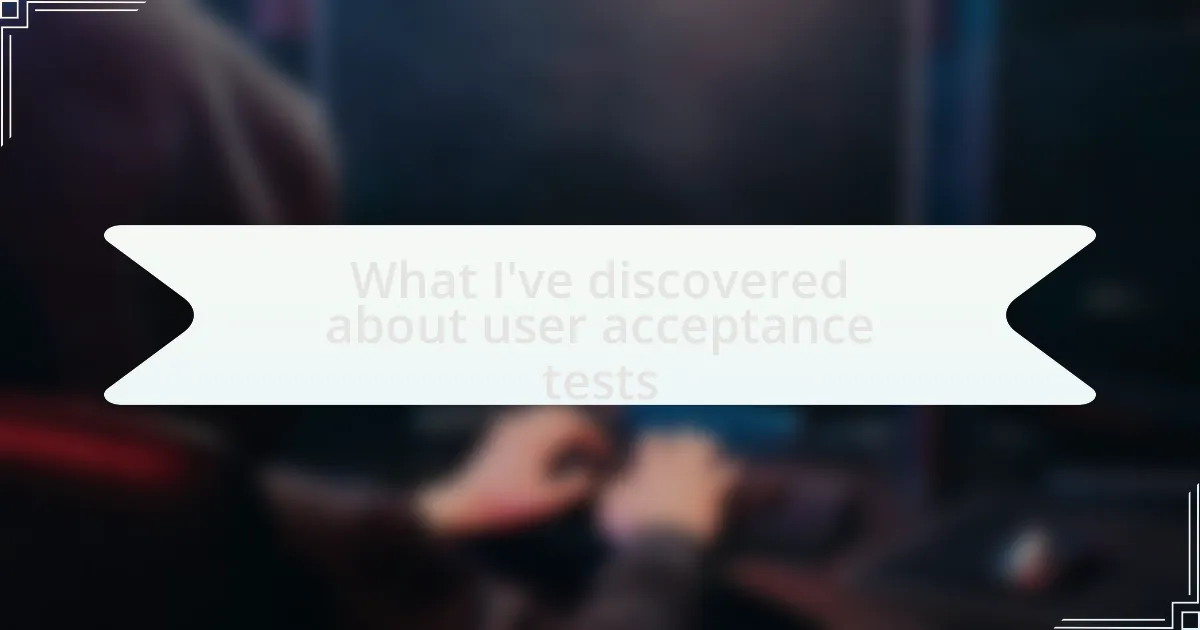Key takeaways:
- User Acceptance Testing (UAT) is crucial for ensuring software meets real user needs, influencing project success significantly.
- User feedback during UAT can reveal critical usability flaws and enhance product relevance, fostering a user-centric approach.
- Creating a safe environment for honest user feedback boosts collaboration and uncovers essential insights often overlooked by developers.
- Clear communication is vital during UAT; using accessible terminology can prevent confusion and improve user engagement with the software.
Author: Oliver Bennett
Bio: Oliver Bennett is an acclaimed author known for his gripping thrillers and thought-provoking literary fiction. With a background in journalism, he weaves intricate plots that delve into the complexities of human nature and societal issues. His work has been featured in numerous literary publications, earning him a loyal readership and multiple awards. Oliver resides in Portland, Oregon, where he draws inspiration from the vibrant local culture and stunning landscapes. In addition to writing, he enjoys hiking, cooking, and exploring the art scene.
Understanding user acceptance testing
User acceptance testing (UAT) is that pivotal moment when the software transitions from the development phase to real-world application. I still remember my first experience observing this process; the tension in the room was palpable as users began to interact with the software. It was fascinating to see how their feedback, often filled with genuine enthusiasm or frustration, shaped the final product.
When conducting UAT, I often found myself pondering, “Are we truly meeting the users’ needs?” This question drives the process, making it essential to gather insights directly from those who will use the software. The goal here is to ensure the end product aligns with user expectations, addressing their concerns and preferences.
It’s eye-opening to realize that UAT isn’t just a checkbox on a project timeline; it can significantly influence the project’s success. I vividly recall a project where user feedback during testing revealed a major usability flaw that, if left unnoticed, would have led to considerable user dissatisfaction post-launch. That experience taught me that this phase is crucial; it’s where developers and users can truly connect, laying the groundwork for a more user-centric product.
Importance of user acceptance tests
User acceptance tests (UAT) are essential because they empower users to validate the software against their real-world needs. I’ll never forget the time I conducted a UAT session for a project involving a complicated inventory management system. As users expressed their confusion over certain features, I was reminded that without their input, we risked releasing a product that simply didn’t resonate with its target audience. It’s a stark reminder that user feedback is critical; after all, who better to judge functionality than those who will actually use it?
Another aspect of UAT that I find vital is the emotional connection it builds between developers and users. During one testing phase, users shared stories about how they envisioned using the software to improve their work-life balance. Their passion and excitement breathed new life into our team, reinforcing a shared commitment to create something meaningful. Isn’t it amazing how a project can transform from mere lines of code into a tool that positively impacts lives, all because we took the time to listen?
Moreover, the importance of UAT extends beyond immediate feedback; it can have long-term implications for user satisfaction and software adoption. For instance, I once worked on a project where the initial UAT revealed that users preferred a different layout for information display. Implementing their suggestions not only improved usability but also fostered loyalty among users who felt their opinions were valued. This experience made it clear to me: prioritizing user feedback during UAT isn’t just a good practice; it’s a pathway to building lasting relationships and fostering trust.
Lessons learned from my experiences
I’ve learned that flexibility during UAT can lead to surprising breakthroughs. On one occasion, we encountered a feature that users absolutely loved but that had been initially deemed unnecessary by the development team. This unexpected enthusiasm opened my eyes to the importance of being open to revising our priorities and embracing the creativity of our users. Have you ever hesitated and then realized that collaboration could lead to a much richer outcome? This experience certainly taught me that UAT can sometimes unveil hidden gems.
One of the most impactful lessons I’ve gleaned is the significance of creating a safe space for honest feedback. During one session, I encouraged users to express not only their likes but also their frustrations without fear of hurt feelings. The authenticity of their comments was refreshing, and it brought to light several critical issues we hadn’t noticed. It made me wonder: how often do we, as developers, unintentionally stifle honest conversation? I now prioritize fostering an environment where users feel empowered to share their true thoughts, which ultimately enriches the testing process.
Another key takeaway is the necessity of clear communication throughout UAT. I remember a project where the users were excited about the features but confused by the terminology we used in our documentation. Their bewilderment led me to realize that jargon can create barriers, even when the intent is to help. It reinforced my belief that our role is not just to build software but to ensure that it’s comprehensible and accessible to those who will use it. Don’t you think we can bridge gaps simply by choosing our words thoughtfully?

Leave a Reply